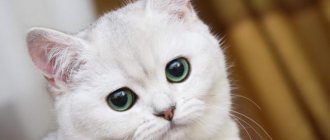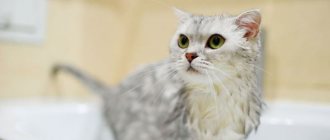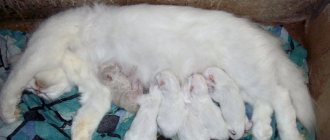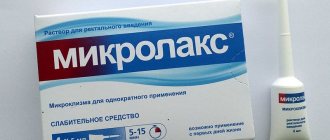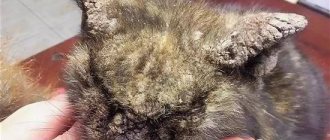How to treat lichen in a cat - this question worries many people who have had to deal with this disease. When a pet begins to itch and hair falls out in certain areas of the body, owners may become confused and not understand how to properly treat the animal.
To cure lichen, you need to understand what skin infection your pet has contracted and how to properly treat it.
How to treat different types of lichen in cats
To answer the question of how to cure lichen in a cat and how to understand that the disease is going away, you need to understand the types of skin lesions. By knowing the specific forms of the disease, you can find out how long treatment should be carried out and when it is better to stop if the animal develops lichen.
Shearer
In medical terminology, this form of lichen is called dermatophytosis. Ringworm appears on the cat's head and begins to spread throughout the body. After the head, lichen appears on the ears, neck, then on the back and paws of the pet.
The more the cat scratches, the faster the shingles will spread. Ringworm of this form is treated with various antibacterial ointments, antifungal drugs and gels.
Weeping
Weeping lichen in cats is significantly different from ringworm. It is not contagious. In a kitten and an adult cat, the appearance of lichen may indicate a deterioration of immunity and a lack of vitamins in the body. Wet lichen manifests itself as eczema.
When the body is affected, reddish spots initially appear on the animal’s body. Gradually, bubbles filled with exudate grow in these places. If nothing is done, they will begin to burst and turn into abscesses. Ringworm of this form is treated with various ointments (sulfuric, salicylic acid, tar).
Pink
One of the most unstudied forms of lichen. Scientists cannot determine the reasons why pityriasis rosea appears. Most experts claim that this form of lichen occurs due to weakened animal immunity and allergic reactions.
It appears as small pink spots with flaky skin in the center. In order to cure a cat, you need to change its diet (change food), stop bathing it and treat the affected areas of the skin with apple cider vinegar.
Diagnosis of lichen
Self-examination of the cat is not enough to make a diagnosis of ringworm. In this case, it is necessary to undergo a luminescent analysis. This type of procedure involves shining through the fur with ultraviolet rays. If the disease is present, the coat will have a green tint.
Some veterinary clinics may also do other tests, such as scraping the affected area, to confirm the diagnosis. This type of research allows you to see under a microscope the fungal spores that live on the cat’s body and understand how to treat the animal.
How to treat ringworm in cats at home
To choose an effective remedy for treating skin diseases in your pet, you need to take your cat to the veterinarian. The specialist will prescribe effective comprehensive treatment. Medications:
- Fungin for cats;
- Miramistin;
- Fukortsin for lichen for cats;
- Triderm;
- Akriderm;
- Chlorhexidine;
- Ivermek;
- Terbinafine;
- Fungin forte.
A very popular remedy is Fluconazole for cats against lichen, the dosage of which is selected by the veterinarian. Self-medication using medications is strictly prohibited. Otherwise, you can aggravate the situation and harm the cat.
The treatment regimen will directly depend on the form of the disease. Treatment products can be for external use (ointments, gels, aerosols, drops) or internal (capsules and liquid suspensions).
To quickly cope with a viral or fungal disease, immunomodulators and antibiotics are used.
At home, the affected areas can be smeared with iodine, potassium permanganate, grease and tar. When using these remedies, it is necessary to monitor the body's reaction. If your pet gets worse from using them, you should contact your veterinarian.
How to treat ringworm in a cat at home at the initial stage
If symptoms occur, treatment should be started immediately. In the first stages, you can do without medications.
You can use anti-lichen shampoos for cats, which are sold in any veterinary stores. Instructions for use and dosage are indicated on the shampoo packaging.
Anti-lichen sprays for cats (Fungin or Biopirox) are considered another effective remedy used to treat lichen in the early stages of the disease. It is enough to treat the affected areas of the cat’s skin with an aerosol twice a day until the general condition improves.
When treating the initial stage of lichen, it is not necessary to use potent compounds and drugs.
Getting rid of the disease in a generalized form
When standard medications are powerless and the disease continues to progress, it is necessary to begin more radical methods of treatment.
Treatment of herpes
Treatment of this pathology, especially recurrent and chronic forms, currently presents significant difficulties. This is explained by the persistence of this virus in the human body, as well as specific immunodeficiencies that form in the body of patients. It must be taken into account that frequent exacerbations, untimely consultation with a doctor and the low effectiveness of many treatment methods used by patients independently cause a significant deterioration in the physical and mental condition of patients.
The required amount of treatment for a patient with herpes simplex is determined by the clinical form, stage and severity of the disease. To prescribe the most optimal treatment methods, patients have to undergo clinical and laboratory examination. Today, with significant development in the pharmacological field, quite strong drugs have appeared to treat this viral infection. Therefore, timely treatment can prevent further development of the disease and significantly improve the patient’s physical and mental condition; it is worth remembering that in case of complications of the disease, the treatment process is long; at the slightest source of infection, consult a doctor.
How to remove ringworm from a cat using folk remedies
Treatment of lichen in cats at home is based on the use of various herbs, products and substances that can be found in the kitchen of most housewives or in pharmacies and grocery stores:
- Celandine is a well-known folk remedy used to treat various skin diseases in both humans and animals. At the break of the stems of this plant, yellow juice appears, which should be used to lubricate the affected areas of the skin.
- Lemon juice - destroys pathogens and accelerates tissue regeneration. It is not recommended to treat kittens in this way, because lemon juice is considered a potent remedy. They lubricate the affected areas of the skin twice a day.
- Newspaper ash is often used to treat skin diseases. It is applied to the affected areas of the epithelium once every 24 hours. It effectively kills germs and restores the integrity of the skin.
Many owners smear the spots formed from lichen with brilliant green. This can be classified as a home treatment, however, when applying it yourself, you need to follow the dosage.
Routes of infection
More than 90% of the world's population are carriers of the herpes simplex virus. By the age of 30-40, almost 100% of people encounter it. Once infected with herpes, a person remains a carrier of the virus for the rest of his life. The infection is always transmitted from person to person, and the greatest probability of infection occurs during the acute phase of the disease, but it remains possible when it is asymptomatic. That is, you can get the herpes simplex virus from a carrier even if he does not have visible lesions on the skin and other symptoms of the disease. Type I herpes is found in saliva and other biological fluids of the body, so pathogens can be acquired through airborne droplets (by coughing, sneezing) or through household contact (by shaking hands, kissing, through shared utensils and hygiene items). A baby can also become infected with herpes from the mother while still in the womb, during childbirth, or while breastfeeding. With an adequately functioning immune system, some time after infection, the virus disappears from tissues and internal organs, but continues to persist in sensitive nerve fibers, making a person its lifelong carrier.
Disinfection and prevention
When your pet is completely cured of the skin disease, it is necessary to treat the apartment for cat lichen. Sometimes it is not possible to disinfect an apartment. In such situations, the owners do not know what to do with the cat during treatment.
One option is to place him in a specialized clinic. While your pet is away, you need to thoroughly clean the entire room and wash all surfaces with bleach.
To prevent lichen, you need to get vaccinated in a timely manner, comb your pet's fur more often, bathe it once a week with soap, and not allow it to come into contact with other cats. This way you can significantly reduce the risk of developing lichen.
Your cat's health can be preserved with timely diagnosis and proper treatment. Without proper treatment, skin infections will develop stronger and stronger, which will lead to a worsening of the animal’s general condition.
Can a person or another pet get shingles?
It is important to remember that dermatophytosis is a contagious disease to other pets and humans. However, infectiousness also depends on the immunity of the animal or person in contact with the sick person.
The incubation period ranges from one to three weeks, and the manifestation of clinical signs depends on risk factors.
Main risk factors:
- age (young and older dogs and cats get sick more often);
- damaged skin (presence of abrasions and scratches);
- concomitant diseases (for example, immunodeficiency in cats);
- stress.
Long-haired cats are often carriers of dermatophytosis type M. canis. About 10–90% of cats are so-called asymptomatic carriers (without showing clinical signs). Up to 90% of cases of human dermatophytosis are caused by the same type of M. canis and the source of infection is cats.
But a person (or pet) can also become infected from a dog. Yorkies and hunting breeds are predisposed to dermatophytosis.
Infection occurs when fungal hyphae attach to a weakened organism. Subsequently, they descend into the hair follicles, in which the fungus forms spores. Subsequently, clinical symptoms appear and the pet can infect the person or animals with which it has been in contact, especially if their immunity is weakened.
In cats, the muzzle area, ears, and forelimbs are often affected. In dogs - head, neck, limbs.
Description of the disease
Depending on the type of lichen, the rash may be dry or weeping, pale pink or bright red.
Most often, the disease affects the back, face and chest of the child (it is in these areas that the largest number of sweat glands are located). The disease is infectious in origin and is caused by viruses or fungi. The disease most often manifests itself in the spring-summer season, when it is warm and humid outside. At the moment, a large number of varieties of lichen are known. Many of them are highly contagious and potentially dangerous to the child’s immediate environment. That is why, if there is any suspicion of an infectious disease, it is necessary to immediately show the patient to a qualified specialist.
Routes of transmission of ringworm
Spores of the fungus that causes the disease can spread quickly through the air, in the aquatic environment and through clothing.
Main routes of transmission:
- in direct contact with a sick animal (if protective equipment is not used);
- with indirect contact, infection can occur through pet care items - a bed, food bowls, harness or leash;
- through other carriers of infection - rodents (mice and rats);
- in the environment, spores can spread with water or through the air, through soil, sand, garbage, upon contact with which the fungus begins to develop;
- through items of clothing or shoes of the owner or other people coming into the house.

